The reality of today’s business climate is that organizations must make difficult decisions to survive. This means business turbulence is going to occur and affect the employee experience.
It can be easy to deprioritize the employee experience amid economic uncertainty — but that’s shortsighted. A positive employee experience has a strong correlation to improved customer experiences, better business outcomes, and long-term growth.
Conversely, negative employee experiences, employee disconnection, and ill-thought-out organizational changes that are not centered on the employee can lead to high attrition and burnout and can negatively impact your brand and reputation.
Related Content: The ROI of Organizational Culture
Even during these challenging moments, there is an opportunity to foster connections. Organizations need to slow down and purposely plan changes by leveraging data to enhance employee experience and organizational effectiveness and minimize risk. To accomplish this, we’re sharing how to use an employee journey framework and map it to our employee experience model to drive pivotal and measurable outcomes for your employees and your business.
# Breaking Down the Employee Experience
Often, culture and employee experience are used interchangeably and while they are tightly connected, they are separate. Culture is the sum of everything the people in an organization think, say, and do. The employee experience is how each individual experiences that. Culture impacts employee experience and, conversely, employee experience impacts culture.
At Propeller, based on our in-depth experience, we’ve created an employee experience model that unpacks the different elements that contribute to an employee’s experience. It seeks to simplify, drive impact, and protect and improve those moments of connection by focusing on the power of the employee experience.
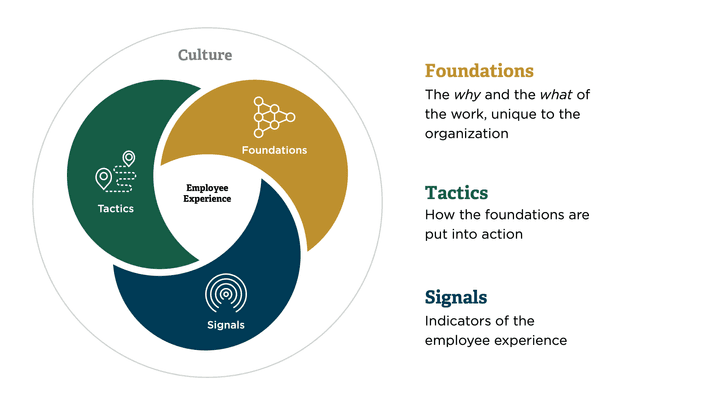
# Three Core Components of the Employee Experience
- Foundations – This is the why and the what of the work that is unique to each organization. Every organization has its own business strategy and mission that is underpinned by its values, purpose, and objectives. These, in theory, are infused throughout the organization and provide direction and focus.
- Tactics – Tactics are how the foundations are put into action. They can be categorized into three spheres: organizational (org structure, policies, procedures), physical (working environment), and digital (data and technology that power the business).
- Signals – These are the indicators of the employee experience. These signals or behaviors help us understand how employees are experiencing their journey within the organization.
Based on our research, these are what employees place a high value on:
- Purpose
- Autonomy
- Trust
- Belonging
- Relationships
- Growth
- Mastery
- Well-being
Related Content: How to Harness the Employee Voice to Cultivate Change
# Signals Are Data and Key to Understanding and Measuring Impact
The employee journey can help organizations understand how and where data can be leveraged. Data is so important when it comes to understanding, driving, and measuring the impact on employee experience — and signals can provide that data. To illustrate this, take a look at the employee journey model below with the key signals overlaid across the employee journey with sample metrics. These metrics are the things that you can use to understand whether your employees are actually experiencing and meeting the indicators against those values that you’ve identified. For example, an employee’s sense of belonging can be measured by engagement scores or benefits utilization.
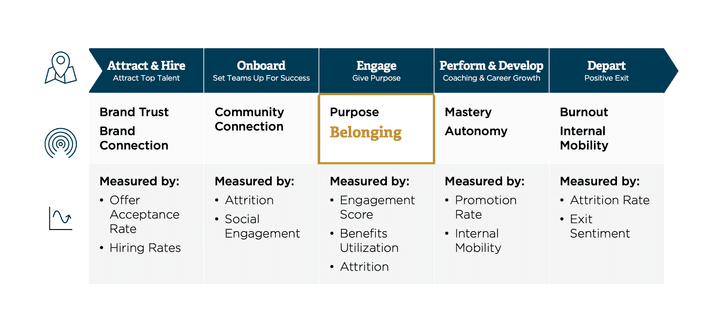
# Propeller’s Employee Journey Model Bridges the Moments That Matter and Opportunities for Creating Connection
The focus of employee experience is to make employees feel valued and connected along their employee journey. To help bridge the moments that matter with opportunities for connection, we’ve created an employee journey model that maps the employee journey alongside our employee experience model.
Bringing these two together forces organizations to think of the employee experience from different lenses. The employee journey makes you see it through the employee’s perspective and ensures you are thinking about those impactful moments and opportunities for connection. Then, the employee experience model encourages you to look at things from a system level.
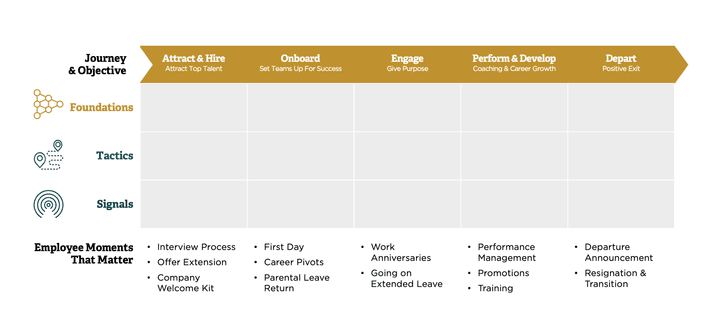
To help bring this to life, let’s walk through how we applied this framework to impact the employee experience for one of our clients.
# A Case Study: Employee Experience Agenda Driven By HR
Our client, a global sports retailer, was undergoing an org-wide HR technology transformation but was struggling with the complex lingering impacts of the pandemic. They had a strategic mandate to invest in improving the employee experience but needed help understanding where they could have the most impact on the employee experience.
Following the above framework, we started with an inquiry and conducted a series of focus groups, one-to-one interviews, and a survey. We then combined this information with existing data like social engagement and 90-day surveys. Collectively, these data points produced a signal indicating where the employee experience needed attention: onboarding.
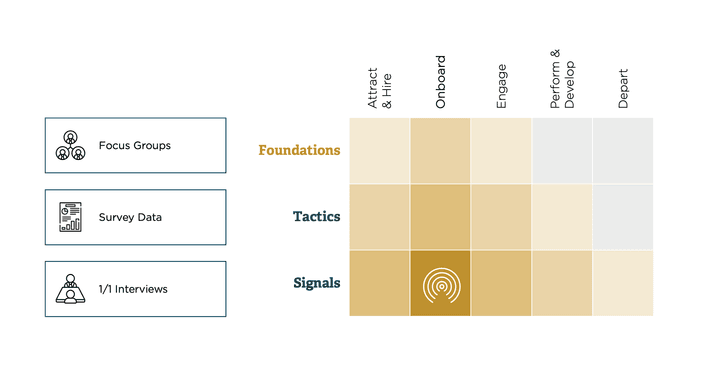
Connection and belonging were the top signals the data showed for employees during onboarding. Employees were not feeling a sense of belonging, given many were joining the organization virtually.
As one person said during the data collection: “I felt on an island…it was hard to connect to the ‘why’ and build my professional community from a distance.”
This is exactly what we needed to change.


Leveraging the other components of the model we helped the organization build a plan to remedy these challenges.
- Starting with foundations, we needed to figure out how to better connect new employees to the organizational mission and goals — even when joining remotely. We worked with leadership to understand the strategic commitments to the employees. Then, we used these to explore how to create experiences to deliver on these commitments. That’s where the tactics come in.
- To start, we identified the best-in-class virtual onboarding experiences with three tactics rising to the top: a virtual onboarding roadshow, equality and belonging groups, and a buddy system. Tactics must solve the right problem, so we piloted a few ideas to test and see what would stick.
- Leveraging the last component of the framework, signals, we needed to see whether the tactics we applied were having the desired effect. We needed to define what measures and signals, balancing both quantitative and qualitative data, needed to be in place to understand if the changes were having the desired impact.
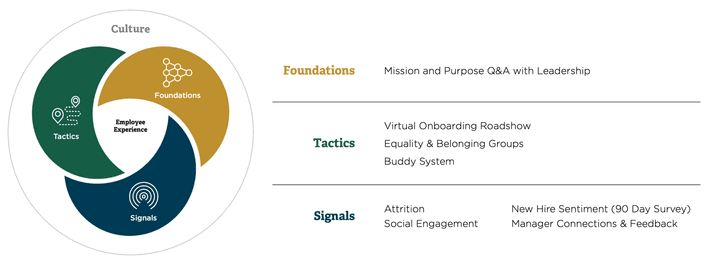
By applying our framework, we helped the organization slow down and identify where they could land the most impact and achieve a strong ROI on their employee experience investments.
# Conclusion — Help Your Organization Slow Down and Think About the Impact
Today, there is so much angst around economic uncertainty and organizations are going to have to make changes to survive. And this ultimately means changes for employees, too. By utilizing this framework, your organization can slow down and begin to think about the impacts of those big changes on the employee journey.
To get started, remember:
- Protect and champion connection.
- Follow the data to lead to the well of the problem.
- Apply the framework creatively.
If I can leave you with one thing, it is that it’s all about connections — they are the start and end of every employee’s experience.




